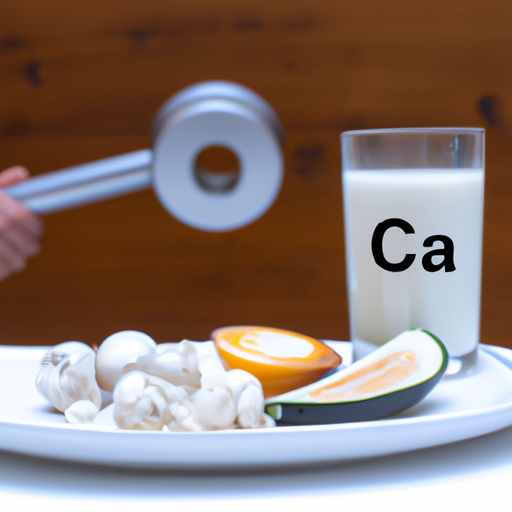- Your cart is empty
- Continue Shopping
Building Strong Bones: The Key to Preventing Osteoporosis through Diet and Lifestyle Changes

Osteoporosis, a condition characterized by weak and brittle bones, affects millions of people worldwide, particularly older adults. As bone health plays a crucial role in maintaining overall well-being and mobility, it is essential to understand the causes, symptoms, and diagnosis of osteoporosis. Moreover, adopting a diet that supports bone health is key in preventing and managing this condition. In this article, we will explore the various aspects of osteoporosis, including its causes, symptoms, and diagnosis. Additionally, we will delve into the role of diet in promoting bone health, highlighting key nutrients and their recommended intake. Lastly, we will discuss treatment options and lifestyle changes that can help prevent and manage osteoporosis effectively. By empowering ourselves with knowledge and making necessary changes, we can strengthen our bones and protect ourselves from the debilitating effects of osteoporosis.
1. "Understanding Osteoporosis: Causes, Symptoms, and Diagnosis"
Osteoporosis is a condition characterized by weakened bones, making them more prone to fractures. It primarily affects older adults, particularly women, but can also occur in men. Understanding the causes, symptoms, and diagnosis of osteoporosis is crucial in order to prevent and effectively manage this condition.
Causes:
Several factors contribute to the development of osteoporosis. The most common cause is a decline in estrogen levels in women during menopause. Estrogen plays a vital role in maintaining bone density, so its reduction can lead to bone loss. Other risk factors include a family history of osteoporosis, low calcium and vitamin D intake, sedentary lifestyle, smoking, excessive alcohol consumption, and certain medical conditions such as rheumatoid arthritis and hyperthyroidism.
Symptoms:
Osteoporosis is often referred to as the "silent disease" because it is typically asymptomatic until a fracture occurs. However, some individuals may experience back pain, height loss, a stooped posture, and frequent fractures with minimal trauma. It is essential to be aware of these signs and seek medical attention if they arise, especially if you are at high risk for osteoporosis.
Diagnosis:
To diagnose osteoporosis, healthcare professionals utilize various methods. The most common diagnostic tool is a bone mineral density (BMD) test, which measures the amount of minerals in a specific bone, usually the hip or spine. The results are compared to those of a young, healthy individual, providing a T-score that determines the density of your bones. A T-score of -1 or above is considered normal, while a score between -1 and -2.5 indicates osteopenia (low bone density) and a score below -2.5 confirms a diagnosis of osteoporosis.
Other diagnostic tests may include blood tests to assess calcium, vitamin D, and hormone levels, as well as a thorough medical history and physical examination. These evaluations help identify the underlying causes of bone loss and determine the most appropriate treatment plan.
In conclusion, understanding the causes, symptoms
2. "The Role of Diet in Bone Health: Key Nutrients and Recommended Intake"
A balanced diet plays a crucial role in maintaining bone health and preventing osteoporosis. Consuming a variety of nutrient-rich foods provides the necessary vitamins and minerals that support bone formation and strength. Let’s explore some key nutrients and their recommended intake for optimal bone health.
1. Calcium: Calcium is the most well-known nutrient for bone health. It helps in the formation and maintenance of strong bones. Adults aged 19-50 require around 1000 mg of calcium per day, while adults over 50 should aim for 1200 mg. Good sources of calcium include dairy products like milk, cheese, and yogurt, as well as fortified plant-based milk alternatives, leafy green vegetables, and tofu.
2. Vitamin D: Vitamin D is essential for calcium absorption and utilization by the body. It promotes bone mineralization and helps maintain proper levels of calcium and phosphorus in the blood. The recommended daily intake of vitamin D varies depending on age and other factors. Generally, adults should aim for 600-800 IU (international units) per day. Natural sources of vitamin D include fatty fish like salmon and mackerel, fortified dairy products, egg yolks, and exposure to sunlight.
3. Magnesium: Magnesium contributes to bone mineralization and is involved in the conversion of vitamin D into its active form. It also helps regulate calcium levels in the body. The recommended daily intake of magnesium for adults is around 310-420 mg. Good sources of magnesium include whole grains, nuts, seeds, legumes, leafy green vegetables, and dark chocolate.
4. Vitamin K: Vitamin K is necessary for the synthesis of proteins involved in bone mineralization. It helps improve bone density and reduce the risk of fractures. The recommended daily intake of vitamin K for adults is 90-120 mcg. Excellent sources of vitamin K include leafy green vegetables like kale, spinach, and broccoli, as well as fermented foods like natto.
5. Protein: Adequate protein intake is essential for bone health, as it provides the building blocks necessary
3. "Preventing and Managing Osteoporosis: Treatment Options and Lifestyle Changes"
Osteoporosis, a condition characterized by weak and brittle bones, affects millions of people worldwide. While it is more common in older individuals, it can also occur in younger adults and even children. The good news is that there are various treatment options and lifestyle changes that can help prevent and manage osteoporosis effectively.
One of the primary goals of treating osteoporosis is to prevent fractures and further bone loss. To achieve this, healthcare professionals often recommend a combination of medication, dietary changes, exercise, and lifestyle modifications.
Medication plays a crucial role in the treatment of osteoporosis, especially for individuals at high risk of fractures. There are different types of medications available, including bisphosphonates, hormone-related therapy, selective estrogen receptor modulators, and calcitonin. These medications work by either slowing down bone loss or increasing bone density. It is important to consult with a healthcare professional to determine the most suitable medication based on individual needs and medical history.
In addition to medication, dietary changes are essential for maintaining healthy bones. A well-balanced diet rich in calcium and vitamin D is vital for bone health. Calcium is the building block of bones, and vitamin D helps the body absorb calcium effectively. Good sources of calcium include dairy products, leafy greens, tofu, and fortified foods. Vitamin D can be obtained from sunlight exposure or through dietary sources like fatty fish, egg yolks, and fortified products. If necessary, calcium and vitamin D supplements can also be recommended by healthcare professionals.
Regular exercise is another key component in preventing and managing osteoporosis. Weight-bearing exercises, such as walking, jogging, dancing, and weightlifting, help stimulate bone growth and increase bone density. It is essential to engage in activities that put stress on the bones to promote their strength and resilience. However, individuals with osteoporosis should always consult with their healthcare provider before starting any exercise program to ensure safety and suitability.
Lifestyle modifications are equally important in managing osteoporosis. Avoiding tobacco and excessive alcohol consumption is crucial, as both can contribute

